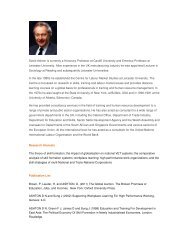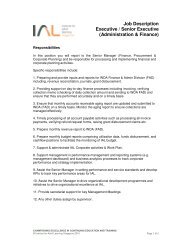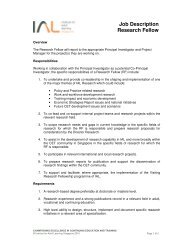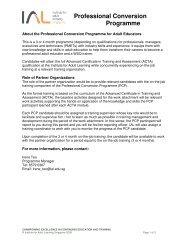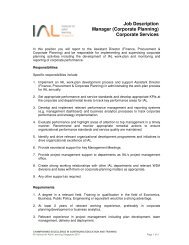Challenges affecting the integration of competency-based training at ...
Challenges affecting the integration of competency-based training at ...
Challenges affecting the integration of competency-based training at ...
You also want an ePaper? Increase the reach of your titles
YUMPU automatically turns print PDFs into web optimized ePapers that Google loves.
towards finding <strong>the</strong>ir own level <strong>of</strong> equilibrium <strong>at</strong> a societal level to decidebetween providing and gaining access to two main types knowledge requiredby workers and learners, i.e.: “knowledge for performing <strong>at</strong> <strong>the</strong> workplace” and<strong>the</strong> “knowledge for performing beyond <strong>the</strong> workplace‖. Such stakeholder’ssuccess in establishing socially acceptable trade-<strong>of</strong>fs will likely contribute to<strong>the</strong> society’s choices between <strong>the</strong>se two types <strong>of</strong> knowledge, usually as part<strong>of</strong> a wider societal level life-long learning policy. These policies in turn willcontribute to <strong>the</strong> factors deciding how knowledge is tre<strong>at</strong>ed within educ<strong>at</strong>ion,VET, curriculum and incorpor<strong>at</strong>ed within CBT.By tracing <strong>the</strong> history <strong>of</strong> <strong>the</strong> development and implement<strong>at</strong>ion <strong>of</strong> NQF andconsidering <strong>the</strong> evidence uncovered from reviewing <strong>the</strong> historicaldevelopment <strong>of</strong> <strong>the</strong> NVQ framework, it is possible to conclude th<strong>at</strong> a broad orholistic interpret<strong>at</strong>ion <strong>of</strong> competence did not take root as a result <strong>of</strong> <strong>the</strong>considerable challenges faced by <strong>the</strong> policy makers in <strong>the</strong>ir―oper<strong>at</strong>ionalis<strong>at</strong>ion‖ as originally envisioned within UK’s White Papers <strong>of</strong> <strong>the</strong>1980’s. The distorted interpret<strong>at</strong>ion <strong>of</strong> <strong>the</strong> definition <strong>of</strong> competence and policymaker’s devi<strong>at</strong>ion from <strong>the</strong> initial version <strong>of</strong> <strong>the</strong> ―Job Competence Model‖ hadcontributed significantly to <strong>the</strong> eventful limited NVQ form <strong>of</strong> competence whicheventually took shape had ironically resulted in a performance-orient<strong>at</strong>ed ornarrow interpret<strong>at</strong>ion <strong>of</strong> competence and CBT perme<strong>at</strong>ing throughout <strong>the</strong> NQFsystem <strong>of</strong> <strong>the</strong> 1980’s, as criticised by Bob Mansfield, (Burke 1989, p 33). Both<strong>the</strong> AQF (2010) and WSQ systems, in <strong>the</strong> process <strong>of</strong> adapting <strong>the</strong> NVQmodel, have inadvertently also incorpor<strong>at</strong>ed <strong>the</strong>ir performance-orient<strong>at</strong>ed form<strong>of</strong> competence <strong>at</strong> <strong>the</strong> inception phase <strong>of</strong> implementing <strong>the</strong>ir respective NQFs.Similar to <strong>the</strong> NVQ experience, <strong>the</strong> AQF and WSQ systems also appear tohave orchestr<strong>at</strong>ed <strong>the</strong>ir respective accredit<strong>at</strong>ion requirements in favour <strong>of</strong>performance-orient<strong>at</strong>ed <strong>training</strong> and assessment methods, which in turn hasfostered a <strong>training</strong> environment which is conducive developing programmespertaining to routine and directly observable tasks, mostly <strong>at</strong> <strong>the</strong> lower levels<strong>of</strong> <strong>the</strong>ir respective qualific<strong>at</strong>ions.Such a performance-orient<strong>at</strong>ed form <strong>of</strong> competence has contributed to <strong>the</strong>wide ranging critique <strong>of</strong> <strong>the</strong> CBT approach and <strong>of</strong>ten such critiques aremistakenly directed <strong>at</strong> <strong>the</strong> ―principle <strong>of</strong> competence‖ ra<strong>the</strong>r <strong>the</strong> ―form‖. Thel<strong>at</strong>ter <strong>of</strong> course is <strong>at</strong> <strong>the</strong> heart <strong>of</strong> this issue is wh<strong>at</strong> needs to be addressed as<strong>the</strong> ―distortions‖ resulting from <strong>the</strong> ―oper<strong>at</strong>ionalis<strong>at</strong>ion‖ <strong>of</strong> NVQ hasinadvertently limited <strong>the</strong> potential for <strong>the</strong> maximis<strong>at</strong>ion <strong>of</strong> learning andassessment throughout <strong>the</strong> CBT approach <strong>at</strong> all levels <strong>of</strong> qualific<strong>at</strong>ions. It isonly after years <strong>of</strong> research on <strong>the</strong> results <strong>of</strong> <strong>the</strong> implement<strong>at</strong>ion <strong>of</strong> CBT andafter implementing a series <strong>of</strong> continuous improvement practices in <strong>the</strong>execution CBTA th<strong>at</strong> UK and Australia have begun to address <strong>the</strong> issue byincorpor<strong>at</strong>ing much more innov<strong>at</strong>ive and flexible learning and assessmentstr<strong>at</strong>egies. Such a fresh perspective towards competence would not bepossible if not for VET practitioners taking reference and learning from <strong>the</strong>best practices implemented in <strong>the</strong> educ<strong>at</strong>ional contexts <strong>of</strong> outcome <strong>based</strong>academic educ<strong>at</strong>ion and for <strong>the</strong>ir willingness to accept a much broader orholistic form <strong>of</strong> competence.This fresh <strong>at</strong>titude towards NQF and CBT had resulted in both <strong>the</strong> Australianand UK n<strong>at</strong>ional qualific<strong>at</strong>ions’ authorities revising <strong>the</strong>ir definitions, as part <strong>of</strong>Copyright © 2011 Institute for Adult Learning 7









